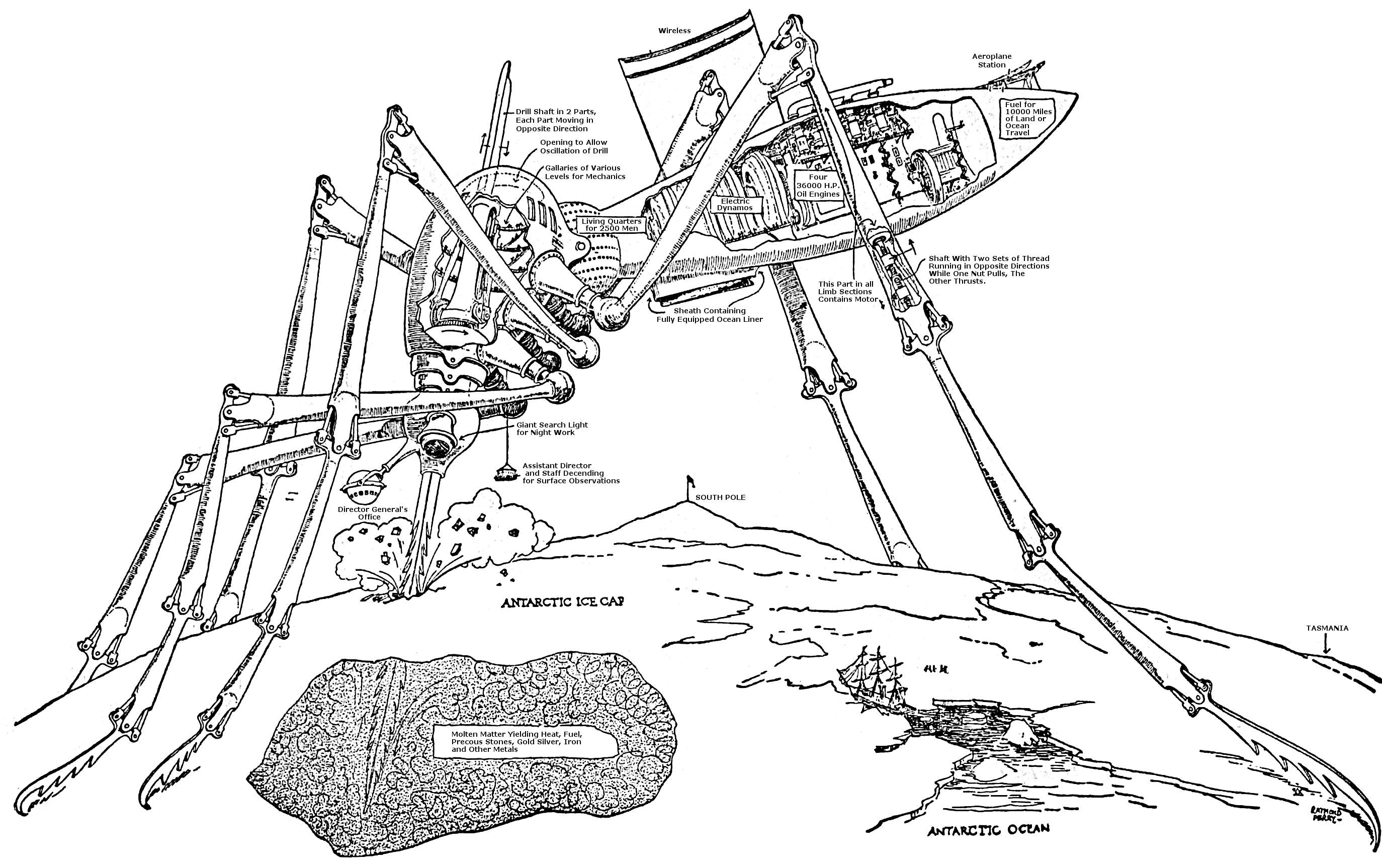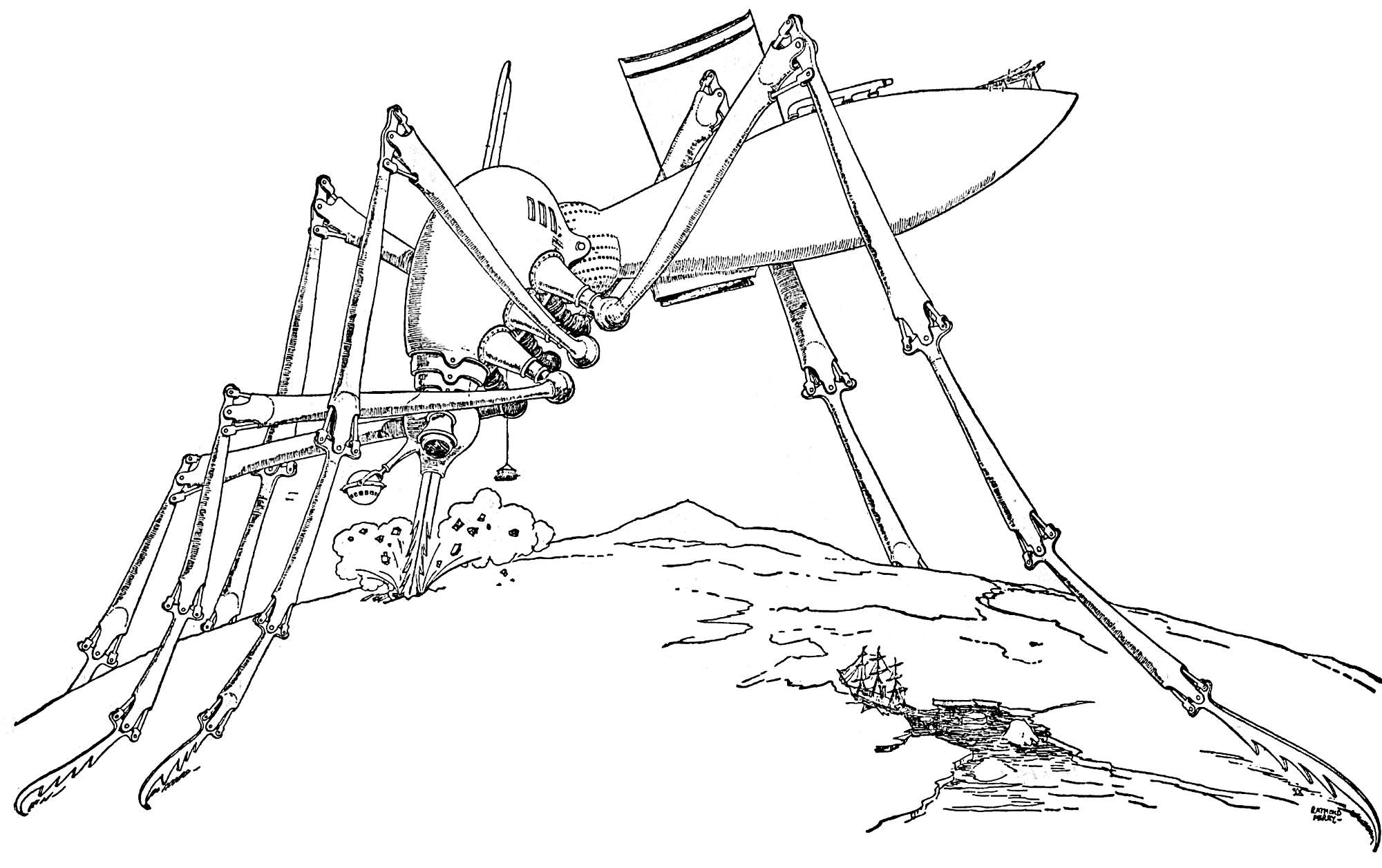The SS Harvard was built in 1907 and was the SS Charles until it was acquired by the Pacific Navigation Company (and renamed) in 1913.
It operated as a passenger steamer until 1918 when the US Navy purchased her and renamed it the USS Charles
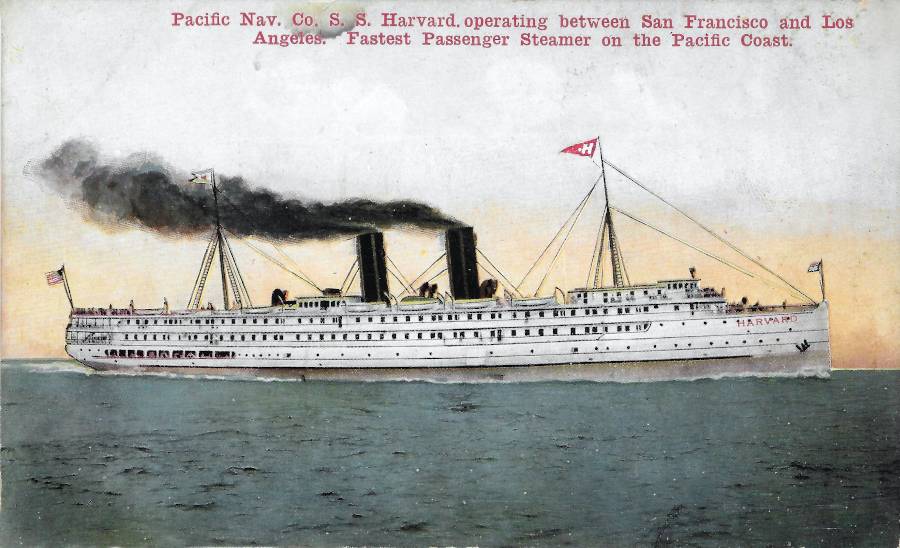
Tag: 1913
The Vampire, 1913
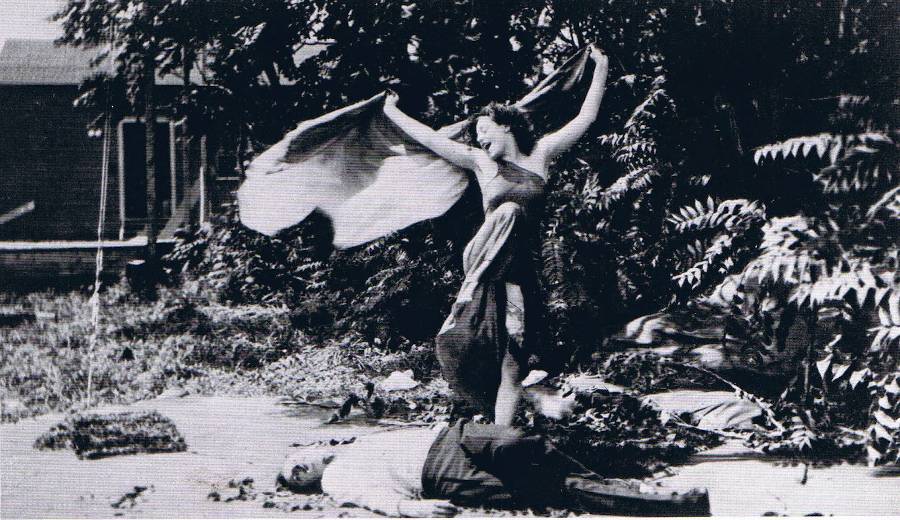 Alice Eis and Bert French performing the “Vampire Dance”
Alice Eis and Bert French performing the “Vampire Dance”
Continue reading “The Vampire, 1913”
Strange Hunt for Atlantis
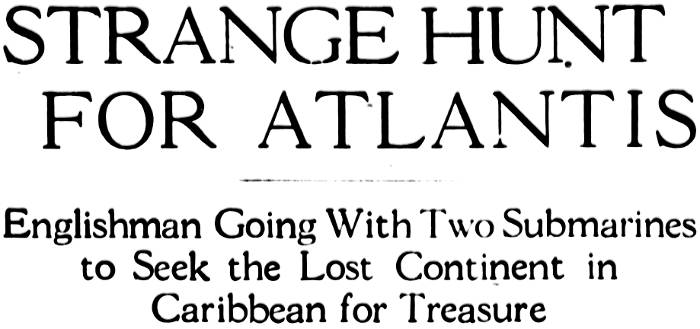
AN eminent astronomer recently declared that all the mysterious places of earth had been penetrated by adventurous man. “There is left,” he said, “no portion of our planet that he has not trod. The star gazer Is now the only true explorer.
Man’s future discoveries must be made with the telescope.”
But there is still a large part of the earth’s crust that is as great and fascinating a mystery as the illimitable reaches of space. Hidden there may lie the cities of a wonderful race, with vaults choked with precious metals and rare Jewels. He who brings them to light will write his name beside those of Marco Polo, Columbus, Vasco da Gama, Livingstone, Peary and all the others who have extended our frontiers of geographical knowledge. Continue reading “Strange Hunt for Atlantis”
The Ferocious Man-eating Tree of Madagascar
It is from seven to ten feet high and something like a grape fruit in shape, with rough, ugly tendrils stretching out in all directions. The trunk is black and hard as stone.
At the top of. the tree are six palpi, six feet high, that rear straight up and twine and whirl about incessantly. There is a cup also at the top which contains a clear, appetizing looking fluid. But alas for him who drinks it. He becomes peculiarly crazed and unable to get down.
Then it is that the whirling palpi twine themselves slowly but surely about the helpless man until all life is gone. This species of tree is naturally avoided as a deadly serpent would be, and the natives consider that it is actually alive and possessed of an evil and terrible spirit. (Arizona Republican, October 19, 1913)
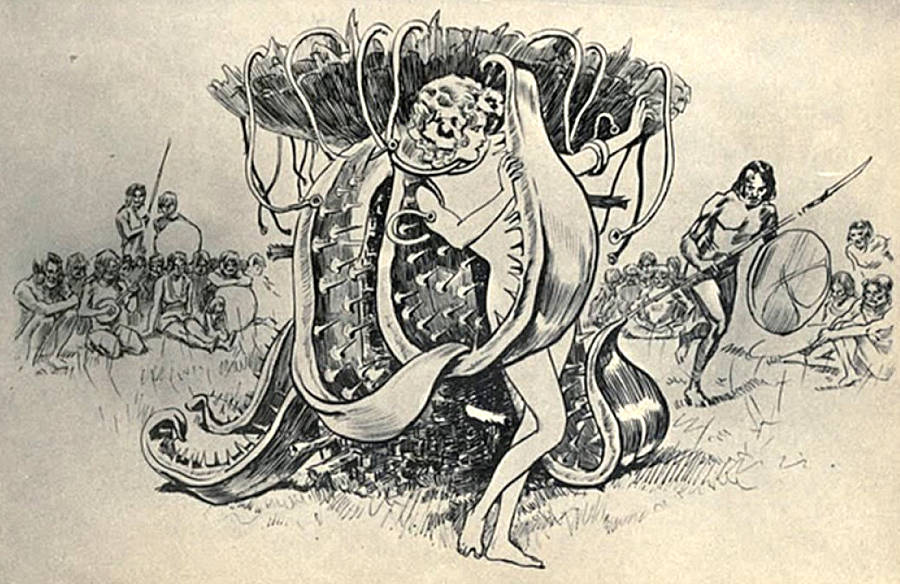 Sacrificed to a man-eating plant. American Weekly. September 26, 1920
Sacrificed to a man-eating plant. American Weekly. September 26, 1920
The Man in the Moon is Dying, 1913
The Greatest Land-Dragon Ever Known, 1913
From the The San Francisco Call., September 25, 1913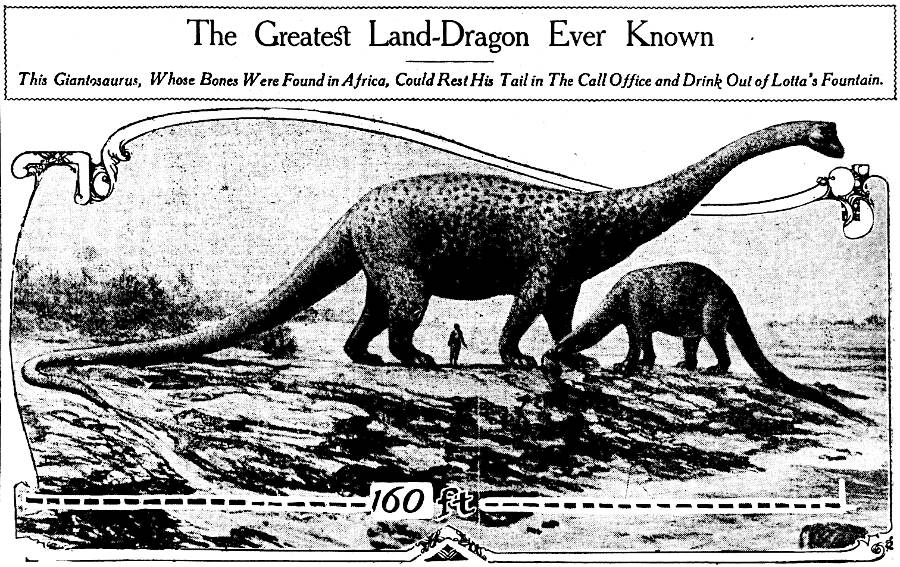
HERE is an astonishing picture of the reconstructed Gigantosaurus Africanus, the most prodigious creature that has come to light. Our special artist has now reconstructed the great land dragon and has set it by a man and Diplodocus Carnegii, to emphasize its enormous size. Recent discoveries have revealed in Africa remains of a land dragon whose length measured some 160 feet, or about the distance from The Call office across Market street to Lotta’s fountain. The monster was discovered by German savants at Tendaguru, in German East Africa. An almost complete skeleton was obtained. The cast of the upper arm bone, or humerus, now at the British Museum of Natural History, South Kensigton, and descriptions of the rest of the skeleton show that this colossal beast was a near relation of Diplodocus Carnegii, in Pittsburgh. Now, Diplodocus was just 84 feet long and stood 11 feet high at the shoulder. His arm bone measured just 3 feet 3 inches long. The arm bone of the new giant, Gigantosaurus Africanus, was as long as the whole leg of Diplodocus; it measures now just 7 feet 1 inch, but during life it was certainly some inches longer, for no allowance has been made for the gristle which must have capped both ends. It may be that Gigantosaurus may lose something of his glory, at any rate as far as his length is concerned, for it is assumed that he was a long tailed dragon, like his American cousin. He may not have been. In height Diplodocus was nowhere; his 11 feet at the shoulder is far eclipsed by the 22 feet of his rival. Naturally, it is difficult, not to say dangerous, to dogmatize on the theme of the habits of Gigantosaurus. 11c lived during that remote period of the world’s history during which the lower cretaceous rocks were formed; a period which antedated the birth of man by several million years. We shall probably be not far from the truth in regarding him as an aquatic, or. at any rate, an amphibious creature. That he was a vegetarian is shown by his teeth, and that he was dull witted is proved by the ridiculously small size of his brain cavity, less than would hold a man’s fist. A man is placed in the drawing (under Gigantosaurus Africanus) merely for the comparison of size.
I Can’t Drive… 15…
Giant Mechanical Mosquito, 1913
Self-moving mechanisms modelled on the lines of gigantic mosquitoes and designed to enable man to conquer Nature in those places where the climate or the formation of the country make it impossible for him to enter or to remain for any length of time.
The outer frame is 48½ feet square, and it stands 33 feet high from the bottom of the spuds to the working deck level. The inner stage is 29½ feet by 40¼ feet. In the body are the engines which, provide its motive power and the quarters for a crew of ten men. The head is nothing more than a huge engine, from which are operated the drills, cutting tools, lifting cranes or whatever it is that is necessary for the work at hand. The machines will be made of steel and aluminum, and are not inordinately heavy. They are run by the Diesel oil machines.
Finally their use as war engines, as terrible as the fanciful “walking tripods” of Mr. Wells’s Martians, is being brought to the attention of the Italian Government.
95 Years of Crosswords
 This flapper doesn’t seem to be interested in crossword puzzles, which was the newest craze in 1924. The history of the crossword puzzle dates back to December 21, 1913, when the Sunday New York World printed Liverpudlian Arthur Wynne newest puzzle he called a “word-cross.” The puzzle was an immediate success and became a weekly feature. Though it was a popular regular feature it didn’t become a craze until 1924, when an upstart publishing house by the name of Simon & Schuster compiled a collection of the puzzles in book form.
This flapper doesn’t seem to be interested in crossword puzzles, which was the newest craze in 1924. The history of the crossword puzzle dates back to December 21, 1913, when the Sunday New York World printed Liverpudlian Arthur Wynne newest puzzle he called a “word-cross.” The puzzle was an immediate success and became a weekly feature. Though it was a popular regular feature it didn’t become a craze until 1924, when an upstart publishing house by the name of Simon & Schuster compiled a collection of the puzzles in book form.


